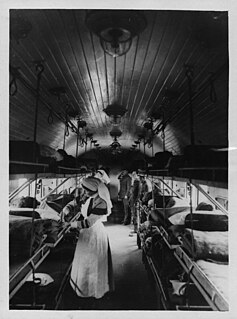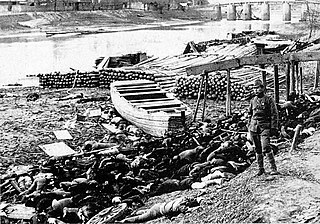The Women's Land Army was a British civilian organisation recreated in 1939. It was first created during World War I so women could work in agriculture.
Women's Land Army may also refer to:
The Women's Land Army was a British civilian organisation recreated in 1939. It was first created during World War I so women could work in agriculture.
Women's Land Army may also refer to:

Conscription, sometimes called the draft in the United States, is the mandatory enlistment of people in a national service, most often a military service. Conscription dates back to antiquity and it continues in some countries to the present day under various names. The modern system of near-universal national conscription for young men dates to the French Revolution in the 1790s, where it became the basis of a very large and powerful military. Most European nations later copied the system in peacetime, so that men at a certain age would serve 1–8 years on active duty and then transfer to the reserve force.

The United States Army (USA) is the land service branch of the United States Armed Forces. It is one of the eight U.S. uniformed services, and is designated as the Army of the United States in the U.S. Constitution. As the oldest and most senior branch of the U.S. military in order of precedence, the modern U.S. Army has its roots in the Continental Army, which was formed to fight the American Revolutionary War (1775–1783)—before the United States of America was established as a country. After the Revolutionary War, the Congress of the Confederation created the United States Army on 3 June 1784 to replace the disbanded Continental Army. The United States Army considers itself to be a continuation of the Continental Army, and thus considers its institutional inception to be the origin of that armed force in 1775.
The United States Armed Forces are the military forces of the United States of America. It consists of the Army, Marine Corps, Navy, Air Force, Space Force, and Coast Guard. The president of the United States is the commander-in-chief of the Armed Forces and forms military policy with the Department of Defense (DoD) and Department of Homeland Security (DHS), both federal executive departments, acting as the principal organs by which military policy is carried out. All six armed services are among the eight uniformed services of the United States.

The Grand Army of the Republic (GAR) was a fraternal organization composed of veterans of the Union Army, Union Navy, Marines and the U.S. Revenue Cutter Service who served in the American Civil War. It was founded in 1866 in Springfield, Illinois, and grew to include hundreds of "posts" across the nation. It was dissolved in 1956 at the death of its last member, Albert Woolson (1850–1956) of Duluth, Minnesota.

The Women's Land Army (WLA) was a British civilian organisation created in 1917 during World War I so women could work in agriculture. It was revived from the disbanded World War One organisation in 1939 so that it could again organise women to replace workers called up to the military. Women who worked for the WLA were commonly known as Land Girls. In effect the Land Army operated to place women with farms that needed workers, the farmers being their employers. They picked crops and did all the jobs that the men had done. Notable members include Joan Quennell, later a Member of Parliament.

Rosie the Riveter was an allegorical cultural icon of World War II, representing the women who worked in factories and shipyards during World War II, many of whom produced munitions and war supplies. These women sometimes took entirely new jobs replacing the male workers who joined the military. Rosie the Riveter is used as a symbol of American feminism and women's economic advantage. Similar images of women war workers appeared in other countries such as Britain and Australia. The idea of Rosie the Riveter originated in a song written in 1942 by Redd Evans and John Jacob Loeb. Images of women workers were widespread in the media in formats such as government posters, and commercial advertising was heavily used by the government to encourage women to volunteer for wartime service in factories. Rosie the Riveter became the subject and title of a Hollywood film in 1944.

Victory gardens, also called war gardens or food gardens for defense, were vegetable, fruit, and herb gardens planted at private residences and public parks in the United States, United Kingdom, Canada, Australia and Germany during World War I and World War II. In wartime, governments encouraged people to plant victory gardens not only to supplement their rations but also to boost morale. They were used along with Rationing Stamps and Cards to reduce pressure on the public food supply. Besides indirectly aiding the war effort, these gardens were also considered a civil "morale booster" in that gardeners could feel empowered by their contribution of labor and rewarded by the produce grown. This made victory gardens a part of daily life on the home front.

In Great Britain just before World War I there were 24 million adult women and 1.7 million worked in domestic service, 800,000 worked in the textile manufacturing industry, 600,000 worked in the clothing trades, 500,000 worked in commerce, and 260,000 worked in local and national government, including teaching. The British textile and clothing trades, in particular, employed far more women than men and were regarded as 'women's work'. During WWII, in total, 6 million women were added to the workforce in what resulted as a major cultural shift. With the men fighting in the wars, women were needed to take on responsibilities that the men had to leave behind.
Land Girls or variants may refer to:

No man's land is land that is unoccupied or is under dispute between parties who leave it unoccupied out of fear or uncertainty. The term was originally used to define a contested territory or a dumping ground for refuse between fiefdoms. In modern times, it is commonly associated with World War I to describe the area of land between two enemy trench systems, which neither side wished to cross or seize for fear of being attacked by the enemy in the process. The term is also used to refer to ambiguity, an anomalous, or indefinite area, in regards to an application, situation, or jurisdiction.

War crimes were committed by the Empire of Japan in many Asian-Pacific countries during the period of Japanese imperialism, primarily during the Second Sino-Japanese War and World War II. These incidents have been described as an "Asian Holocaust", but this characterisation has been challenged by scholars on the basis of unique features of the Holocaust. Some war crimes were committed by Japanese military personnel during the late 19th century, but most Japanese war crimes were committed during the first part of the Shōwa era, the name which was given to the reign of Emperor Hirohito.

Fort Jackson is a United States Army installation, which TRADOC operates on for Basic Combat Training (BCT), and is located within the city of Columbia, South Carolina. This installation is named for Andrew Jackson, a United States Army General and the seventh president of the United States of America (1829–1837) who was born in the border region of North and South Carolina.

The Women's Army Corps (WAC) was the women's branch of the United States Army. It was created as an auxiliary unit, the Women's Army Auxiliary Corps (WAAC) on 15 May 1942 by Pub.L. 77–554, and converted to an active duty status in the Army of the United States as the WAC on 1 July 1943. Its first director was Oveta Culp Hobby, a prominent woman in Texas society. The WAC was disbanded in 1978, and all units were integrated with male units.

"Marching Through Georgia" is a marching song written by Henry Clay Work at the end of the American Civil War in 1865. The title and lyrics of the song refer to U.S. Army major general William T. Sherman's "March to the Sea" to capture the Confederate city of Savannah, Georgia in late 1864.

The Romanian Land Forces is the army of Romania, and the main component of the Romanian Armed Forces. In recent years, full professionalisation and a major equipment overhaul have transformed the nature of the Land Forces.

The United States declared war on Germany on April 6, 1917, nearly three years after World War I started. A ceasefire and Armistice was declared on November 11, 1918. Before entering the war, the U.S. had remained neutral, though it had been an important supplier to the United Kingdom, France, and the other Allied powers.

The United States Army Nurse Corps was formally established by the U.S. Congress in 1901. It is one of the six medical special branches of officers which – along with medical enlisted soldiers – comprise the Army Medical Department (AMEDD).

The Woman's Land Army of America (WLAA), later the Woman's Land Army (WLA), was a civilian organization created during the First and Second World Wars to work in agriculture replacing men called up to the military. Women who worked for the WLAA were sometimes known as farmerettes. The WLAA was modeled on the British Women's Land Army.

Mary Greyeyes Reid was a Canadian World War II servicewoman. A Cree from the Muskeg Lake Cree Nation in Saskatchewan, she was the first First Nations woman to enlist in the Canadian Armed Forces. After joining the Canadian Women's Army Corps (CWAC) in 1942, she became the subject of an internationally famous army publicity photograph, and was sent overseas to serve in London, England, where she was introduced to public figures such as George VI and his daughter Elizabeth. Greyeyes remained in London until being discharged in 1946, after which she returned to Canada.

The Women's Land Army (WLA) was a British civilian organisation. It was created in 1917 by the Board of Agriculture during World War I to encourage women to work in agriculture, replacing men called up to the military. Women who worked for the WLA were commonly known as Land Girls. In effect the Land Army operated to place women with farms that needed workers, the farmers being their employers. They picked crops and did all the jobs that the men would do. Notable members included the archaeologist Lily Chitty and the botanist Ethel Thomas. It was disbanded in 1919 but revived in June 1939 under the same name.